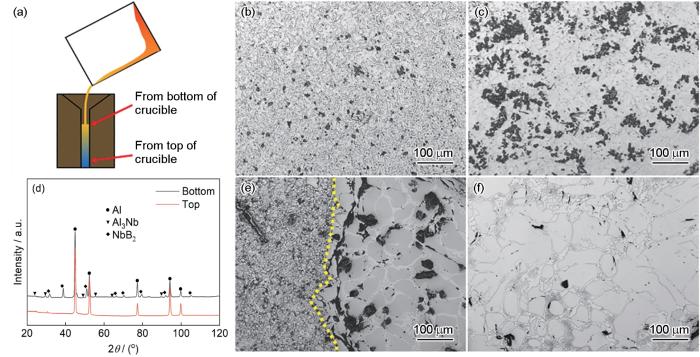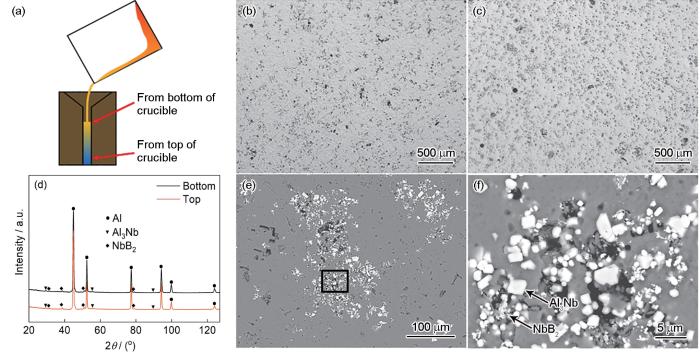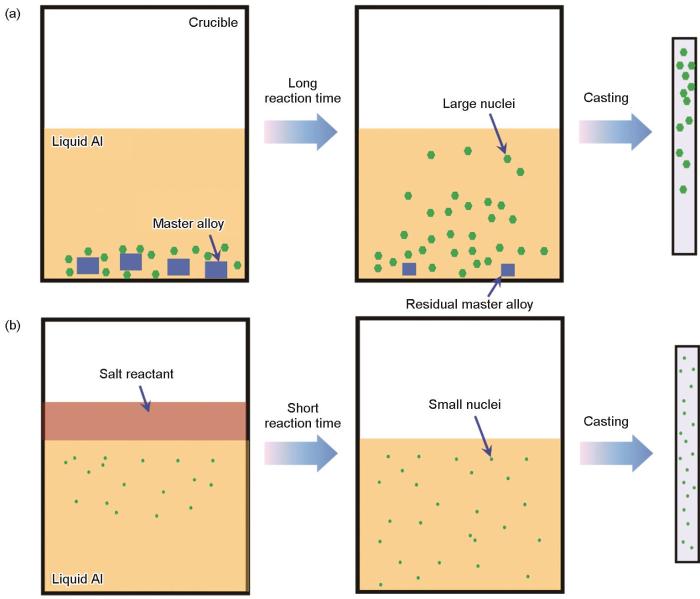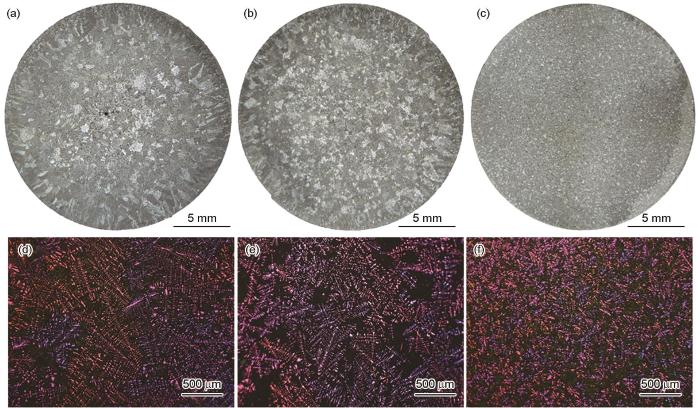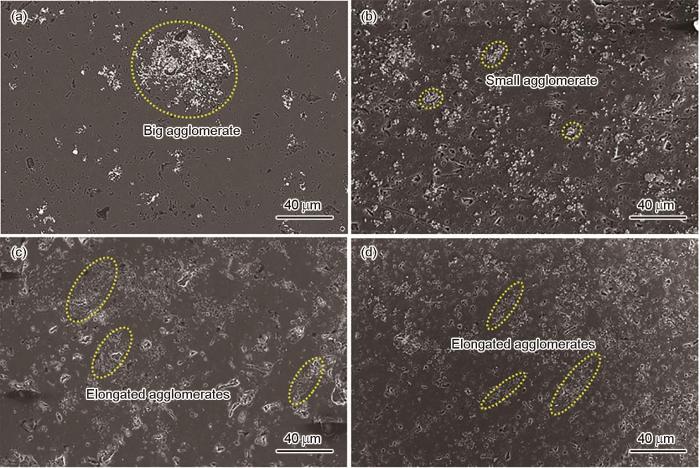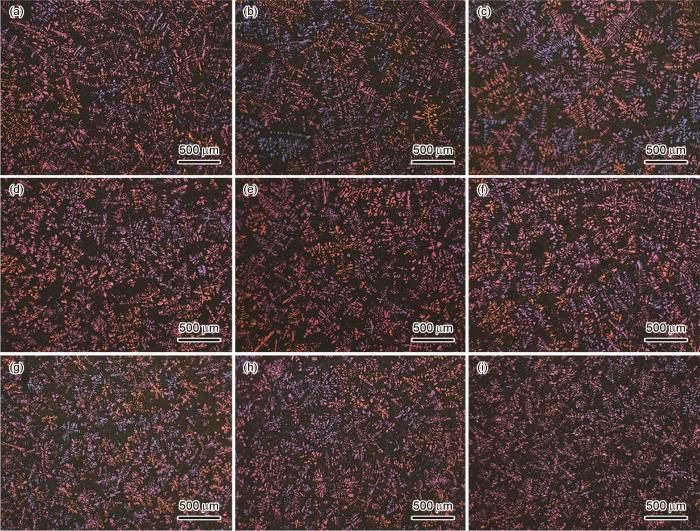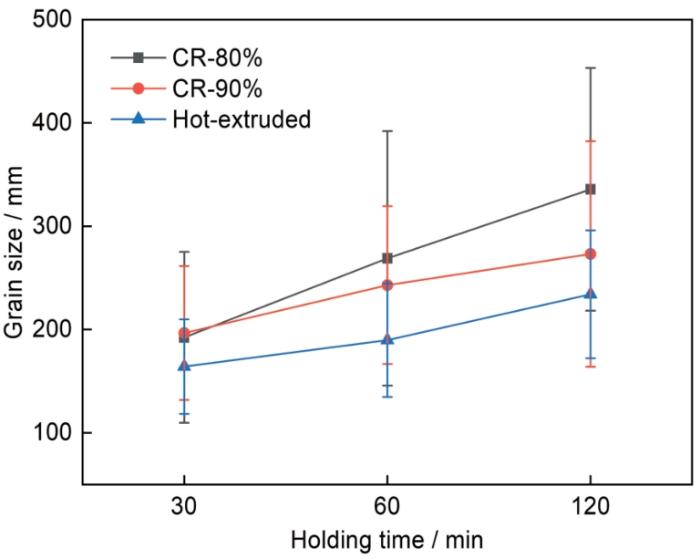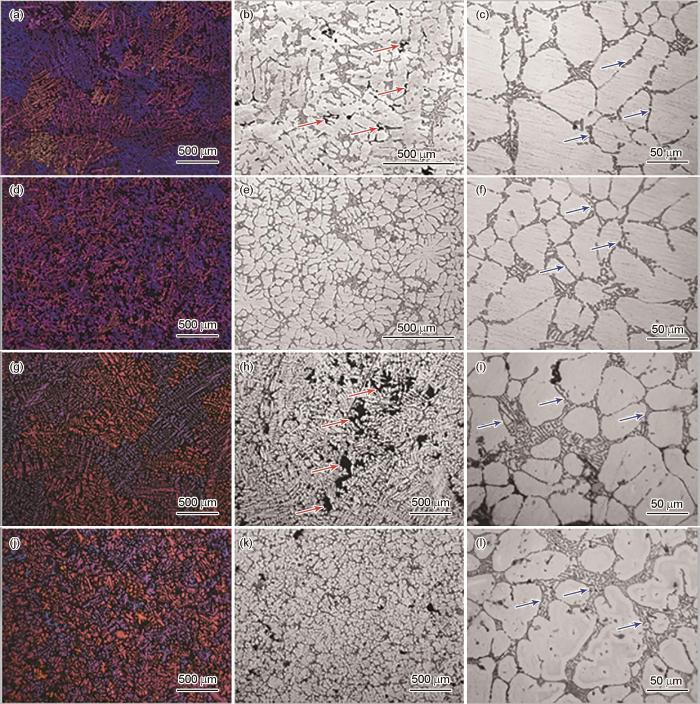早在20世纪40年代,研究人员已开始寻找铸造铝合金的理想细化剂。Eborall[6]在1949年研究了微量元素添加对Al及其合金的细化效果,发现向Al熔体中加入微量Ti元素时,所形成的初晶相可以直接作为α-Al的晶核促进α-Al发生非均匀形核,从而降低α-Al的形核功,提高其形核效率,进而显著细化α-Al的晶粒尺寸。在此基础上,Cibula[7]在1951年研究了Ti元素和B元素对铸造铝合金基体组织的协同细化效果,发现Ti和B元素会与Al液发生熔体反应,生成异质形核质点Al3Ti与TiB2,从而对基体晶粒尺寸起到协同细化作用。此后,随着基础理论不断深化和科研设备大幅改进,国内外研究人员开发出大量铸造铝合金细化剂,如Al-Ti、Al-B、Al-Ti-B、Al-Ti-C和Al-Ti-B-C等,其中Al-Ti-B细化剂的细化速率快、细化效率高,是目前工业生产中应用最为广泛的铸造铝合金细化剂[8]。然而,当铸造铝合金中Si含量高于5% (质量分数)时,Al-Ti-B细化剂中的Ti元素会与铝熔体中的Si元素发生反应,大幅降低其细化效果,该现象被称为细化剂的“Si中毒”现象[9]。关于Al-Ti-B细化剂发生“Si中毒”现象的原因,目前主要有2种代表性理论:反应理论和偏聚理论。反应理论[10]认为,当铝合金中Si元素含量过高时,会与细化剂中的Ti元素反应生成TiSi、TiSi2及Ti3Si5等金属间化合物,从而大量消耗细化剂中的有效形核质点;而偏聚理论[11]认为,Al液中的Si原子会在二维Al3Ti化合物的界面上发生偏聚,从而打破Al3Ti与α-Al之间的共格关系,抑制α-Al在Al3Ti上的外延形核。为解决Al-Ti-B细化剂的“Si中毒”问题,Nowak等[12]在2015年首次提出采用Nb元素代替Al-Ti-B细化剂中的Ti元素,利用Nb元素基本不与Si元素反应的特性开发出了抗Si毒化性能良好的Al-Nb-B细化剂,为Al-Si系合金的铸态组织细化提供了有效手段。需要指出的是,工业生产中常采用传统熔炼法制备Al-Nb-B细化剂,由于原材料熔点高、反应时间长和形核质点密度大等原因,该方法所制细化剂元素收得率低且形核质点分布不均匀,极大地限制了其组织细化效果和工程应用价值[13~15]。
本工作基于熔融盐反应制备了Al-Nb-B细化剂,与传统熔炼法相比,熔融盐反应法所需反应时间较短,可以有效抑制传统熔炼过程中细化剂的粗化、沉降、团聚等问题,在元素收得率、形核质点尺寸及分布、细化效率等方面均具有优越性。在此基础上,对熔融盐细化剂进行塑性变形处理,进一步提高了其中形核质点分布的弥散性,优化了细化剂的组织细化效果和抗衰退性能。最终,以ZL104和ZL114A合金为研究载体,研究该细化剂对铸造铝合金微观组织及力学性能的影响,明确了该细化剂的工程应用价值。
1 实验方法
1.1 细化剂制备
为实现Al-Nb-B细化剂中形核质点的弥散分布,本工作以纯Al、含Nb氟盐及含B氟盐为原材料,通过熔融盐反应法制备了Al-Nb-B细化剂,具体步骤如下:将纯Al放入坩埚中,采用电阻炉将其升温至780 ℃保温30 min;随后将2种氟盐进行充分搅拌混合,用铝箔纸将混合好的粉末加入Al液中,搅拌均匀并保温20 min;最终对金属熔体进行精炼、除气、扒渣和浇铸。作为对比实验,以纯Al、Al-Nb中间合金(Al-66.6Nb)及Al-B中间合金(Al-3B)为原材料,通过熔炼法制备传统Al-Nb-B细化剂,具体步骤如下:将纯Al放入坩埚中,采用感应加热将其升温至1200 ℃保温30 min;随后加入Al-Nb中间合金并保温10 min;之后加入Al-B中间合金并保温30 min;最终对金属熔体进行精炼、除气、扒渣和浇铸。
1.2 细化剂塑性变形
为进一步提高铸态熔融盐细化剂中形核质点分布的弥散性,分别采用热挤压和冷轧2种塑性变形方式对铸态细化剂进行了塑性变形处理。采用YWS-200T卧式挤压机进行热挤压实验,预热温度为280 ℃,预热时间为2 h,挤压比为69。采用LG240二辊式轧机进行冷轧实验,样品轧制厚度减小量分别为80%和90%,分别记为CR-80%和CR-90%。
1.3 细化剂细化效果及抗衰退性能测试
以铸造铝合金ZL104 (Al-10.72Si-0.33Mg-0.17Fe-0.16Mn,质量分数,%)为研究载体,在实验室条件下探究了熔融盐细化剂的细化效果和抗衰退性能。细化效果测试步骤如下:将ZL104合金在坩埚中加热至完全熔化并升温至720 ℃,随后将铸态细化剂母合金(添加量为0.11%,质量分数,下同)加入金属熔体中并充分搅拌,接着将金属熔体在720 ℃保温10 min,最后除气、扒渣并浇入金属模具中。
抗衰退性能测试步骤如下:将ZL104合金在坩埚中加热至完全熔化并升温至720 ℃,控制熔体高度约为20 cm,随后将铸态细化剂母合金(添加量为0.11%)加入金属熔体中并充分搅拌,接着将金属熔体保温至720 ℃并除气、扒渣,静置30、60和120 min后分别取表层金属熔体浇入金属模具中。在研究熔融盐细化剂的抗衰退性能时,为降低熔体冷却速率对晶粒尺寸的影响,采用的模具尺寸(内径约为35 mm)大于细化效果研究中的模具尺寸(内径约为20 mm),因此2部分研究中的晶粒尺寸不具备可比性。
1.4 细化剂对铸造铝合金组织和性能影响测试
以铸造铝合金ZL104和ZL114A (Al-7.58Si-0.46Mg-0.16Fe-0.12Ti,质量分数,%)为研究载体,探究熔融盐细化剂对铸造铝合金微观组织及力学性能的影响。将ZL114A合金在坩埚中加热至完全熔化并升温至720 ℃,随后将热挤压态细化剂母合金(添加量为0.11%)加入金属熔体中并充分搅拌,接着对金属熔体进行精炼、除气和扒渣,最后将其浇入石膏模具中。
1.5 微观组织表征
采用数码相机观测铸态铝合金的宏观组织,采用配偏振光模式的Axio Scope.A1光学显微镜(OM)和Helios G4 CX扫描电子显微镜(SEM),观察细化剂母合金及铸态铝合金的微观组织,采用Agilent72电感耦合等离子发射光谱(inductively coupled plasma-atomic emission spectroscopy,ICP-AES)定量分析合金的元素含量,采用D8 Discover X射线衍射仪(XRD,CoKα)标定合金的相组成,采用SEM附带的能量色散X射线谱仪(EDS)表征各相元素含量,采用截线法测量铸态铝合金的晶粒尺寸(grain size,GS)和二次枝晶臂间距(secondary dendrite arm spacing,SDAS),其中GS为5张金相照片测量结果的平均值,SDAS为10张金相照片测量结果的平均值。
1.6 力学性能测试
力学性能测试前,对ZL104和ZL114A进行热处理,热处理参数参考GB/T 117—2013标准,其中固溶温度为535 ℃,固溶时间为12 h,时效温度为160 ℃,时效时间为6 h。利用Instron 3382型电子万能材料试验机测试合金的室温准静态单向拉伸性能,拉伸应变速率为5 × 10-4 s-1,拉伸试样为棒状试样,尺寸参考GB/T 228.1—2010标准,其平行段直径为6 mm,标距长度为30 mm。利用Instron 450 MPXJ2型摆锤冲击试验机测试合金的室温冲击性能,锤头提升最大角度为150°,冲击试样为无缺口试样(铸造Al-Si合金脆性较大,开缺口将降低实验准确性),尺寸参考GB/T 34556—2017标准,其长宽高分别为50、10及5 mm。2种力学性能测试中,每种试样至少重复3组实验,以保证数据的可靠性。
2 实验结果与分析
2.1 熔炼细化剂铸态微观组织
图1b~e为熔炼细化剂铸态微观组织和XRD谱。如图1a所示,细化剂母合金在浇铸过程中,坩埚顶部细化剂先于坩埚底部细化剂被浇入模具中。如图1d所示,坩埚不同位置熔炼细化剂的相组成差异较大,其中坩埚底部细化剂中存在大量的Al3Nb和NbB2,2者均为Al-Nb-B细化剂的有效形核质点[16,17];而坩埚顶部细化剂中Al3Nb和NbB2的衍射信号非常微弱。图1b和c为熔炼细化剂铸态组织的OM像,图中黑色颗粒为细化剂中的有效形核质点,即Al3Nb和NbB2,其平均尺寸约为10 μm。对比图1b和c发现,坩埚底部细化剂中形核质点的密度远高于坩埚顶部,该结果与XRD测试结果一致。此外,坩埚底部存在异常组织(图1e虚线右侧),其组织特征与原材料Al-Nb中间合金的微观组织(图1f)高度相似,该现象表明,采用熔炼法制备细化剂时,存在显著的中间合金不完全溶解问题。采用ICP-AES测试熔炼细化剂的元素收得率,其中坩埚底部细化剂的Nb和B收得率均为60%,而坩埚顶部细化剂的Nb和B收得率分别为39%和44%,该结果进一步验证了熔炼细化剂中形核质点的分布不均匀性。
图1
图1
熔炼细化剂浇铸示意图、铸态XRD谱和微观组织及其中间合金微观组织的OM像
Fig.1
Pouring schematic (a), XRD spectra (d), and OM images (b, c, e) of the smelting-based inoculant in as-cast state and OM image of Al-Nb intermediate alloy (f)
(b) inoculant from the top of crucible
(c) inoculant from the bottom of crucible
(e) abnormal microstructure from the bottom of crucible on the right side of the yellow dotted line
2.2 熔融盐细化剂铸态微观组织
图2b~e为熔融盐细化剂铸态微观组织和XRD谱。熔融盐细化剂与熔炼细化剂的母合金浇铸过程相似,坩埚顶部细化剂会比坩埚底部细化剂先被浇入模具中(图2a)。如图2d所示,坩埚不同位置熔融盐细化剂的XRD谱中均存在大量与形核质点Al3Nb和NbB2对应的衍射峰,且坩埚底部和坩埚顶部对应形核质点的衍射峰强度基本相同,该结果表明熔融盐细化剂中形核质点分布更均匀。图2b和c为熔融盐细化剂铸态组织的OM像。与熔炼细化剂组织(图1b和c)相似,图2b和c中的黑色颗粒为熔融盐细化剂母合金中的有效形核质点,其平均尺寸约为1 μm,远小于熔炼细化剂中有效形核质点的平均尺寸(约10 μm)。对比图2b和c发现,坩埚不同位置的熔融盐细化剂中形核质点的密度和分布情况高度相似,与XRD测试结果(图2d)一致。图2e和f为熔融盐细化剂的SEM像。图中亮白色颗粒为熔融盐细化剂中的形核质点,依据形貌及尺寸将这些亮白色颗粒分为尺寸较大的有棱角颗粒和尺寸较小的球形颗粒,EDS测试表明,尺寸较大的有棱角颗粒Nb元素含量更低且含有Al元素,为Al3Nb,其平均尺寸约为2 μm;尺寸较小的球形颗粒Nb元素含量更高且含有B元素,为NbB2,其平均尺寸约为0.3 μm。这些形核质点在SEM像中的分布表明,尽管坩埚不同位置的熔融盐细化剂具有较高的宏观均匀性,但其中的形核质点仍具有微观偏聚现象,这可能与熔融盐在反应初期的大块分解有关,其将会影响细化剂的细化效率。坩埚底部熔融盐细化剂的Nb和B收得率分别为70%和90%,而坩埚顶部熔融盐细化剂的Nb和B收得率分别为60%和80%,2种元素在坩埚底部和顶部的收得率差均为10%,进一步体现坩埚不同位置熔融盐细化剂中形核质点的宏观均匀性[18]。
图2
图2
熔融盐细化剂的浇铸示意图、铸态XRD谱和微观组织
Fig.2
Pouring schematic (a), XRD spectra (d), and microstructures of the molten salt-based inoculant in as-cast state (b, c, e, f)
(b) OM image of inoculant from the top of crucible
(c) OM image of inoculant from the bottom of crucible
(e) SEM image the of inoculant
(f) SEM image of the boxed area in Fig.2e
2.3 熔融盐反应法与传统熔炼法对比
对比图1和2发现,与采用熔炼法制备的熔炼细化剂相比,本工作通过熔融盐反应法制备的熔融盐细化剂有3大优势:元素收得率高、形核质点尺寸小及形核质点分布均匀。如图3a所示,采用传统熔炼法制备细化剂母合金时,反应原材料中间合金熔点(约1600 ℃)[13,14]远高于铝合金常用熔炼温度(约750 ℃)[19],其在熔炼过程中以固态形式与Al液反应,过程缓慢且难以充分进行,因此导致反应生成的形核质点容易长大(图1b和c),并在坩埚底部形成不完全反应产物(图1e中虚线右侧),元素收得率较差[15]。此外,反应原材料中间合金的密度(2.8 g/cm3)大于Al熔体密度(2.4 g/cm3)[20],其在熔炼过程中与Al液的反应主要在坩埚底部进行,因此反应生成的形核质点也主要分布在坩埚底部。同时,熔炼反应生成的形核质点Al3Nb和NbB2的密度分别为4.54和6.98 g/cm3[12],均远高于Al熔体密度,因此在熔炼过程中Al3Nb和NbB2会在重力作用下持续沉降至坩埚底部,进一步加剧熔炼细化剂母合金中形核质点的不均匀性(图1b~d)。图3b为熔融盐反应法制备细化剂的原理图。采用熔融盐反应法制备Al-Nb-B细化剂时,反应物为复合熔融盐和纯Al熔体,Nb和B元素主要来源于复合熔融盐。与传统熔炼法采用的高熔点中间合金相比,复合熔融盐与Al液的反应更加迅速,所需反应时间更短,生成的形核质点密度更高、尺寸更加细小(图2b、c、e和f),元素收得率也更高。此外,由于复合熔融盐的密度小于纯Al熔体,因此在反应过程中复合熔融盐位于Al液上方,反应初期生成的细化剂形核质点也主要位于坩埚顶部,这些细化剂形核质点的密度高于纯Al熔体,在反应过程中会发生持续沉降。本工作所选取的熔融盐反应时间较好地匹配了形核质点的生成和沉降速率,因此所得细化剂中形核质点的分布弥散性远高于传统熔炼法。总体来看,熔融盐反应法不仅促进细化剂中形核质点的弥散分布,还降低细化剂中形核质点的平均尺寸,并提高细化剂的元素收得率。
图3
图3
传统熔炼法和熔融盐反应法制备细化剂的机理图
Fig.3
Schematics of different inoculant fabrication approaches
(a) conventional melting approach (b) novel molten salt reaction approach
2.4 铸态熔炼和熔融盐细化剂细化效果对比
以ZL104铸造合金为研究载体,在实验室环境探究了熔融盐细化剂的细化效果,结果如图4所示。图4a和d为无细化剂添加时ZL104合金的铸态微观组织,图4b和e为添加熔炼细化剂时ZL104的铸态微观组织,图4c和f为添加熔融盐细化剂时(细化剂添加量均为0.11%) ZL104合金的铸态微观组织。如图4a~c所示,无细化剂添加的铸态ZL104合金微观组织较为粗大,添加熔炼细化剂后其组织出现细化现象,而添加熔融盐细化剂后其组织细化现象更加显著。通过OM的偏光模式对3种铸态ZL104合金微观组织进行定量分析(图4d~f),无细化剂添加时其GS约为471 μm,添加熔炼细化剂后其GS减小至约310 μm,而添加熔融盐细化剂后其GS急剧减小至约98 μm。对比2种细化剂的细化效果,添加熔炼细化剂后GS减小了34%,而添加熔融盐细化剂后GS减小了79%,熔融盐细化剂的细化效果远超熔炼细化剂。熔融盐细化剂与熔炼细化剂的有效形核质点相同(图1d和图2d),均为Al3Nb和NbB2,因此2者的细化机理相同,即以Al3Nb和NbB2作为铝熔体的异质形核位点,降低α-Al的形核功,从而提高形核效率[12]。熔融盐细化剂中形核质点尺寸更加细小、分布更加弥散(图1b~d和图2b~d),因此其对铝合金熔体的细化效果也更好[21]。
图4
图4
铸态ZL104合金在添加熔炼和熔融盐细化剂前后微观组织的宏观照片和OM像
Fig.4
OM images of as-cast ZL104 alloy under bright field (a-c) and polarization modes (d-f)
(a, d) without inoculant (b, e) with smelting-based inoculant (c, f) with molten salt-based inoculant
2.5 塑性变形对熔融盐细化剂的影响
2.5.1 熔融盐细化剂中形核质点的微观分布均匀性
如图2b~d所示,熔融盐细化剂中形核质点具有优异的宏观均匀性,然而其在微观上仍有不可忽视的偏聚问题(图2e)。这可能是由于复合熔融盐在反应初期大块分解导致铝熔体中的反应物分布不均匀,从而引起反应产物形核质点的微观偏聚现象。细化剂中形核质点的微观偏聚会影响其细化效率,因此进一步采用热挤压和冷轧2种变形方式,探究塑性变形对细化剂形核质点微观分布均匀性的影响。如图5a所示,形核质点在铸态细化剂中有着较为严重的微观偏聚现象,最大团聚体尺寸达到约40 μm。热挤压变形处理后(图5b),细化剂形核质点分布更加均匀,形核质点在微观尺度上的团聚现象明显缓解,最大团聚体尺寸降至约10 μm。与热挤压变形处理相似,冷轧变形处理后(图5c和d),细化剂形核质点的微观分布同样更加均匀,且其均匀程度随冷轧变形量增加而增加。相较于热挤压变形,冷轧变形处理后形核质点团聚体沿轧制方向被拉长,且其对形核质点的均匀化作用小于热挤压变形。这是由于热挤压过程中细化剂母合金的温度更高(280 ℃),且挤压比较大(69),导致细化剂母合金的塑性变形更加充分,从而使细化剂中形核质点的微观分布更加均匀。总体而言,2种塑性变形方式均可提高细化剂母合金中形核质点分布的均匀性,这与Venkateswarlu等[22,23]对Al-Ti-B细化剂进行塑性变形处理的研究结果一致。
图5
图5
不同状态熔融盐细化剂的SEM像
Fig.5
SEM images of the molten salt-based inoculants in different states
(a) as-cast
(b) hot extruded at 280 oC with an extrusion ratio of 69
(c) cold rolled with a thickness reduction of 80% (CR-80%)
(d) cold rolled with a thickness reduction of 90% (CR-90%)
2.5.2 熔融盐细化剂的抗衰退性能
由于密度差异,细化剂中形核质点在细化剂母合金制备及铸造铝合金浇铸过程中均会发生沉降,导致其细化效果逐渐减弱,此现象被称为细化剂衰退[24,25]。研究[26]表明,通过塑性变形提高细化剂中形核质点的分布均匀性,可以有效降低形核质点的沉降速率,从而提高细化剂的抗衰退性能。因此,为探究经不同形变处理后3种熔融盐细化剂的抗衰退性能,测试了其在ZL104铸造合金中分别静置30、60和120 min后的细化效果,结果如图6所示。与冷轧变形处理(图6a~f)相比,热挤压变形处理(图6g~i)后细化剂对铝合金基体组织的细化效果更好,且其抗衰退性能更为优异。这是由于,相较于冷轧变形,热挤压变形处理后细化剂母合金中形核质点的微观分布更加弥散(图5),因此其在铝合金浇铸过程中的沉降速率更慢,抗衰退效果更好[26]。
图6
图6
ZL104熔体在经过不同状态熔融盐细化剂处理后静置不同时间铸态组织的OM像
Fig.6
OM images of as-cast ZL104 alloys treated with the molten salt-based inoculants in CR-80% (a-c), CR-90% (d-f), and hot-extruded (g-i) states and maintained for different durations before pouring
(a, d, g) 30 min (b, e, h) 60 min (c, f, i) 120 min
图7为经不同状态细化剂处理后ZL104熔体在静置不同时间后的晶粒尺寸变化情况。为降低熔体冷却速率对细化剂抗衰退性能测试的影响,熔体冷却速率(20 K/s)低于2.4节所采用的熔体冷却速率(约50 K/s),因此2部分工作中的晶粒尺寸不具备可比性。如图7所示,随着熔体静置时间延长,添加CR-80%态细化剂合金的晶粒尺寸由约192 μm增加至约335 μm,添加CR-90%态细化剂合金的晶粒尺寸由约194 μm增加至约273 μm,添加热挤压态细化剂合金的晶粒尺寸由约162 μm增加至约234 μm。总体而言,3种变形态细化剂的细化效果均随静置时间延长而减弱,这表明3种状态的熔融盐细化剂在铝合金熔体中均存在衰退现象。值得注意的是,在铝合金熔体中静置同样时间后,CR-80%态细化剂的衰退现象最为明显,CR-90%态细化剂和挤压态细化剂的抗衰退性能相当,但是挤压态细化剂在3个静置时间节点的细化效果稳定性优于CR-90%态细化剂,这归因为热挤压变形处理后的细化剂母合金中形核质点在微观尺度上分布更加弥散(图5)。综上可知,挤压态细化剂中形核质点分布最均匀、细化效果最明显、抗衰退性能最为优异,具有较高的工程应用价值。
图7
图7
经过不同状态熔融盐细化剂处理后静置不同时间铸态ZL104熔体的平均晶粒尺寸
Fig.7
Average grain sizes of as-cast microstructure of ZL104 alloys treated with the molten salt-based inoculants in different states and maintained for different durations
2.6 熔融盐细化剂对铸造铝合金微观组织和力学性能的影响
以ZL114A[27~29]为研究对象,探究了挤压态熔融盐细化剂对铸造铝合金微观组织及力学性能的影响。图8为有无细化剂添加下铸态铝合金微观组织的OM像。可以看出,热挤压态熔融盐细化剂对2种铸造铝合金的微观组织均具有明显的细化效果,其中铸态ZL104的GS由无细化剂添加时的约673 μm (图8a)急剧降低至约140 μm (图8d),晶粒细化程度约为79.2%;铸态ZL114A的GS由无细化剂添加时的约702 μm (图8g)急剧降低至约151 μm (图8j),晶粒细化程度约为78.5%。与此同时,2种铸态铝合金基体晶粒均趋于等轴化。铝合金基体晶粒的细化与等轴化均表明,熔融盐细化剂为Al熔体的凝固过程提供了大量的有效形核位点,从而显著降低了α-Al的形核功,提高了其形核效率[12]。此外,晶粒的细化和等轴化有效提高了铝合金熔体的补缩能力[30],缓解了糊状区由于液相补缩能力不足导致的枝晶间缩孔问题(图8b和h中红色箭头所示)[2],有效降低了合金的缩孔数量和缩孔尺寸(图8e和k)。对比图8b和h,无细化剂添加时铸态ZL114A中的缩孔尺寸明显大于铸态ZL104合金,这是由于ZL104合金中Si含量更高,其熔体流动性更好[3,4]。
图8
图8
铸态铝合金在热挤压态熔融盐细化剂添加前后微观组织的OM像
Fig.8
OM images of as-cast ZL104 (a-f) and ZL114A (g-l) alloys under polarization (a, d, g, j) and bright field (b, c, e, f, h, i, k, l) modes (Red arrows indicate shrinkage porosities and blue arrows indicate eutectic Si)
(a-c, g-i) without inoculant (d-f, j-l) with molten salt-based inoculant in hot-extruded state
与组织细化和缺陷减少的现象有所不同,细化剂的添加对SDAS影响较小,添加前后,ZL104合金的SDAS分别为约38 μm (图8b)和约35 μm (图8e),ZL114A合金的SDAS分别为约27 μm (图8h)和约23 μm (图8k),细化剂添加前后2种合金的SDAS变化均不明显。这是由于细化剂主要通过提供异质形核位点来提高基体的形核效率,从而降低基体晶粒尺寸,而SDAS主要由凝固速率决定[31]。因此在浇铸条件一致(浇铸温度、模具材料、模具尺寸及模具温度等参数均相同)的前提下,细化剂对铝合金的SDAS无显著影响。合金中共晶Si相的高倍形貌如图8c、f、i和l所示(图中的α-Al晶粒尺寸不具备统计意义),无细化剂添加时共晶Si相表现为细小颗粒(图8c和i中蓝色箭头所示),而熔融盐细化剂对共晶Si相形貌无明显改变(图8f和l中蓝色箭头所示)。为抑制粗大针状共晶Si相对合金力学性能的影响,本工作在2种合金的浇铸中均进行了标准Sr变质处理[32]。因此,熔融盐细化剂具有良好的化学稳定性,不会影响Sr对含Si铝合金的变质效果[33]。
进一步通过室温准静态单向拉伸实验和室温冲击实验,研究了热挤压态熔融盐细化剂对热处理态ZL104和ZL114A合金力学性能的影响,结果如表1所示。细化剂添加前后,ZL104合金的屈服强度分别为236和240 MPa,抗拉强度分别为273和279 MPa,断裂延伸率分别为1.9%和2.3%;ZL114A合金的屈服强度分别为245和241 MPa,抗拉强度分别为309和310 MPa,断裂延伸率分别为5.0%和5.4%。整体而言,熔融盐细化剂对屈服强度和抗拉强度基本没有影响,但提高了合金的塑性。此外,熔融盐细化剂大幅提高了合金的冲击韧性,ZL104合金的冲击吸收功由0.82 J增加至1.07 J,对应约30%的冲击韧性提升;ZL114A合金的冲击吸收功由1.09 J增加至1.48 J,对应约36%的冲击韧性提升。该结果表明,熔融盐细化剂可有效细化ZL104和ZL114A合金的晶粒尺寸(图8a、d、g和j),并显著促进基体晶粒的等轴化转变,从而提高铝熔体的补缩能力,降低铝合金中的铸造缺陷(图8b、e、h和k)。铝合金中缩孔等铸造缺陷的减少可以有效抑制铸造缺陷引发的材料早期变形损伤行为,降低材料在变形过程中的应力集中,从而提高合金的塑性和冲击韧性[34]。需要指出的是,熔融盐细化剂对ZL104和ZL114A合金的强度无明显影响,这是由于铝合金的Hall-Petch系数极低[35],其晶粒尺寸往往需要达到亚微米甚至纳米级才会表现出明显的细晶强化作用[36],铸造铝合金的晶粒尺寸普遍在上百微米尺度,因此其强度主要受析出相尺寸和共晶Si相形貌影响[32,33,37],而细化剂对共晶Si相形貌无明显影响(图8c、f、i和l)。总体而言,本团队开发的熔融盐反应法可以有效提高Al-Nb-B细化剂中形核质点的分布弥散性,从而提高细化剂对铸造铝合金的细化效果,改善铸件的铸造质量和力学性能,具有较高的工程应用价值。
表1 热处理态铸造铝合金在添加热挤压态熔融盐细化剂前后的拉伸及冲击性能
Table 1
| Material | σ0.2 MPa | σb MPa | ε % | Ak J |
|---|---|---|---|---|
| Virgin ZL104 alloy | 236 | 273 | 1.9 | 0.82 |
| Inoculated ZL104 alloy | 240 | 279 | 2.3 | 1.07 |
| Virgin ZL114A alloy | 245 | 309 | 5.0 | 1.09 |
| Inoculated ZL114A alloy | 241 | 310 | 5.4 | 1.48 |
3 结论
(1) 与传统熔炼法相比,采用熔融盐反应法制备Al-Nb-B细化剂所需反应时间更短,反应生成的形核质点尺寸更小,分布弥散性更高。同时,熔融盐反应法制备细化剂时原材料反应充分,细化剂中Nb和B元素的收得率高。
(2) 与熔炼细化剂相比,熔融盐细化剂对基体晶粒的细化效率更高(34%→79%)。此外,对铸态细化剂进行塑性变形处理,可有效提高其形核质点的分布均匀性。与冷轧变形相比,热挤压变形对形核质点的均匀化效果更好,所得细化剂的细化效果更好,抗衰退性能更为优异。
(3) 熔融盐细化剂可有效细化铸造铝合金ZL104和ZL114A的晶粒尺寸,促进其组织的等轴化转变,并降低合金的铸造缺陷,从而大幅提高合金的塑性和冲击韧性,具有较高的工程应用价值。
参考文献
Development of aluminum alloy materials: Current status, trend, and prospects
[J].
铝合金材料发展现状、趋势及展望
[J].本文综合分析了铝合金材料在航空航天、交通运输等领域的应用现状,论述了我国铝合金材料的产业规模和技术水平。针对我国在一些关键铝合金材料方面存在的短板,以及在高性能铝合金开发、加工工艺与智能控制等原创技术方面的不足,系统梳理了目前我国在铝合金材料方面存在的主要问题。针对汽车、船舶、空天等领域的发展态势,分析了铝合金材料的市场需求。针对我国铝合金材料的产业现状,提出以下发展对策和建议:加强研发体系建设,完善发展环境;优化结构,促进提质增效和协同发展;加强配套政策支持;推进人才队伍建设;推广智能制造和“互联网+”;加强国际合作,尤其是“一带一路”国际合作。解决铝合金材料卡脖子问题,并为铝合金材料向高端化、绿色化方向发展提供重要参考。
Recent advances in hot tearing during casting of aluminium alloys
[J].
Heat treatment of high pressure die cast AlSi7MgMn alloy
[J].
高压铸造AlSi7MgMn合金热处理工艺研究
[J].
Assessing the thermal stability of laser powder bed fused AlSi10Mg by short-period thermal exposure
[J].
Selective laser melting of TiB2/AlSi10Mg composite: Processability, microstructure and fracture behavior
[J].
Grain refinement of aluminium and its alloys by small additions of other elements
[J].
The grain refinement of aluminium alloy castings by additions of titanium and boron
[J].
Development of grain refining mechanism of Al alloys by Al-Ti-B master alloys
[J].
基于Al-Ti-B细化剂的铝合金异质形核机制研究进展
[J].
Understanding grain refining and anti Si-poisoning effect in Al-10Si/Al-5Nb-B system
[J].Grain refinement is critical for fabricating high-quality Al-Si casting components in the application of automobile and aerospace industries, while the well-known Si-poisoning effect makes it difficult. Nb-based refiners offer an effective method to refine Al-Si casting alloys, but their anti Si-poisoning capability is far from being understood. In this work, the grain refining mechanism and the anti Si-poisoning effect in the Al-10Si/Al-5Nb-B system were systematically investigated by combining transmission electron microscope, first-principles calculations, and thermodynamic calculations. It is revealed that NbB2 provides the main nucleation site in the Al-10Si ingot inoculated by 0.1 wt.%Nb Al-5Nb-B refiner. The exposed Nb atoms on the (0 0 0 1) NbB2 and (1 -1 0 0) NbB2 surface can be substituted by Al to form (Al,Nb)B2 intermedia layers. In addition, a layer of NbAl3-like compound (NbAl3’) can cover the surface of NbB2 with the orientation relation of (1 -1 0 0)[1 1-2 0] NbB2//(1 1 0)[1 1 0] NbAl3’. Both of the (Al,Nb)B2 and NbAl3’ intermedia layers contribute to enhancing the nucleation potency of NbB2 particles. These discoveries provide fundamental insight to the grain refining mechanism of the Nb-B based refiners for Al-Si casting alloys and are expected to guide the future development of stronger refiners for Al-Si casting alloys.
A mechanism for the poisoning effect of silicon on the grain refinement of Al-Si alloys
[J].
Insight into Si poisoning on grain refinement of Al-Si/Al-5Ti-B system
[J].
Grain refinement of Al-Si alloys by Nb-B inoculation. Part I: Concept development and effect on binary alloys
[J].
The Al-B-Nb-Ti system: IV. Experimental study and thermodynamic re-evaluation of the binary Al-Nb and ternary Al-Nb-Ti systems
[J].
Development of Al-Nb-B master alloy with high Nb/B ratio for grain refinement of hypoeutectic Al-Si cast alloys
[J].Al-Nb-B master alloy has been regarded as a promising grain refiner that can reduce grain size of hypoeutectic Al-Si casting alloys. However, its grain refinement performance remains to be improved. In this work, the grain refinement efficacy of Al-Nb-B master alloy is significantly enhanced by modifying the Nb/B ratio through thermodynamic calculation. An Al-Nb-B master alloy with optimum Nb/B ratio of 10:1 provides a fully equiaxed structure across the sections of the Al-10Si and commercial Al-9Si-0.08Ti alloys with an average grain size below 220 mu m. The phenomenon is attributed to the existence of NbAl3 and the higher number density of NbB2 at the Nb/B ratio of 10:1, which offers sufficient active nucleating sites to promote the formation of smaller grains. Moreover, the segregation behavior of Si atoms and interfacial energies after doping Si are investigated by first-principles calculations, and the results reveal that Si tends to segregate to the NbAl3/alpha-Al interface, whereas grain refining potency of NbAl3 for Al remains unchanged. This study has implications for strategic design of Al-Si cast alloy with fine and equiaxed grain structure inoculated by grain refiner.
Effect of the salt addition practice on the grain refining efficiency of Al-Ti-B master alloys
[J].
An anti Si/Zr-poisoning strategy of Al grain refinement by the evolving effect of doped complex
[J].
Recent progress on the additive manufacturing of aluminum alloys and aluminum matrix composites: Microstructure, properties, and applications
[J].
An improved practice to manufacture Al-Ti-B master alloys by reacting halide salts with molten aluminium
[J].
The effect of average cooling rates on the microstructure of the Al-20%Si high pressure die casting alloy used for monolithic cylinder blocks
[J].
Assessment of the influence of Al-2Nb-2B master alloy on the grain refinement and properties of LM6 (A413) alloy
[J].
Influence of thermo-mechanical processing of Al-5Ti-1B master alloy on its grain refining efficiency
[J].
Effect of hot rolling and heat treatment of Al-5Ti-1B master alloy on the grain refining efficiency of aluminium
[J].
Settling behaviour of different grain refiners in aluminium
[J].
Segregation of particles and its influence on the morphology of the eutectic silicon phase in Al-7wt.% Si alloys
[J].
Effect of agglomeration on nucleation potency of inoculant particles in the Al-Nb-B master alloy: Modeling and experiments
[J].
Effect of electric field solidification parameters on microstructure and properties of ZL114A alloy
[J].
电场凝固参数对ZL114A铝合金组织与性能的影响
[J].
Effect of aging treatment on mechanical properties and microstructure of low pressure cast ZL114A alloy
[J].
时效处理对低压铸造ZL114A合金力学性能及显微组织的影响
[J].
Mechanical properties and creep mechanism of yttrium and cerium modified ZL114A alloy via vacuum counter-pressure casting
[J].In order to further improve the mechanical properties of complex thin-walled aluminum alloy structural parts, especially the high temperature creep resistance, rare earth yttrium (Y) and cerium (Ce) were applied to modify ZL114A based on vacuum counter-pressure casting process. According to the experimental results of hardness, tensile properties, and creep strain, combined with the influence of rare earth elements on the evolution of the alloy microstructure, the creep mechanism and strengthening mechanism of the modified ZL114A alloy were revealed. The results indicate that the mechanical properties of alloy first increase and then decrease with the increase of Y and Ce, and the optimal addition is 0.3 wt.%. At this time, the creep stress indexes are 3.52 and 3.88 respectively, and the creep process is dominated by dislocation viscous slip. The rare earth atoms can improve the constitutional supercooling and as the core for heterogeneous nucleation which result in the grain refinement of a-Al. Meanwhile, the fragmented eutectic silicon phase changes into fibrous form and the original dendrites gradually spheroidized and developed into equiaxed crystal. Additionally, Y tends to precipitate in block form while the Ce rich phase presents as a ribbon structure, and the both elements are mainly distributed in the grain boundaries and partly dissolved in the alloy matrix. Therefore, the grain boundaries are strengthened due to the dislocation movement is hindered by the rare earth phase via pinning effect. Simultaneously, the weakening of heat resistance due to the coarsening and decomposition of Mg2Si and the diffusion of Mg can be inhibited by Y or Ce atoms at a high temperature. The modification effect of Y is relatively better because of the different of distribution morphology which is contributed to the scale difference in Y and Ce atoms.
稀土钇、铈变质真空差压铸造ZL114A合金的力学性能及蠕变机制
[J].为进一步提升复杂薄壁铝合金构件力学性能,尤其是抗高温蠕变能力,基于真空差压铸造工艺,分别采用稀土钇(Y)、铈(Ce)元素对ZL114A进行变质处理。系统测试了样品硬度、拉伸性能、蠕变应变,观察分析稀土元素对合金组织结构演变的影响,揭示变质ZL114A蠕变机制及强化机理。结果表明,随着Y、Ce含量的增加,ZL114A力学性能均呈先增大后减小的趋势,最优稀土添加量为0.3 wt.%,此时蠕变应力指数分别为3.52和3.88,蠕变过程均由位错粘滞性滑移主导。稀土元素在提升成分过冷的同时可形成异质形核核心,故a-Al晶粒得到一定细化,共晶硅相由碎片状转变为纤维状,原枝晶组织逐渐球化并向等轴晶发展。此外,稀土Y倾向点块状析出,而富Ce相则呈丝带状组织,二者主要分布于晶界处并部分固溶于合金基体。稀土原子起到钉扎作用阻碍位错运动进而强化晶界,并抑制高温下Mg2Si粗化分解以及Mg元素扩散造成的耐热性弱化。归因于稀土原子尺度差异造成的分布形态不同,Y变质效果相对更好。
Dendrite coherency during equiaxed solidification in binary aluminum alloys
[J].
Mechanical properties as a function of microstructure and solidification thermal variables of Al-Si castings
[J].
Effects of Sr-modification, iron-based intermetallics and aging treatment on the impact toughness of 356 Al-Si-Mg alloy
[J].
Grain refinement of Al-Si alloys by Nb-B inoculation. Part II: Application to commercial alloys
[J].
The influences of grain size and morphology on the hot tearing susceptibility, contraction, and load behaviors of AA7050 alloy inoculated with Al-5Ti-1B master alloy
[J].
Superior tensile properties of graphene/Al composites assisted by in-situ alumina nanoparticles
[J].
Grain size effect on tensile deformation behaviors of pure aluminum
[J].
Influence of grain refinement and modification on microstructure and mechanical properties of Al-7Si and Al-7Si-2.5Cu cast alloys
[J].




